Johannes Schneider
Focus on the Likely: Test-time Instance-based Uncertainty Removal
May 02, 2025Abstract:We propose two novel test-time fine-tuning methods to improve uncertain model predictions. Our methods require no auxiliary data and use the given test instance only. Instead of performing a greedy selection of the most likely class to make a prediction, we introduce an additional focus on the likely classes step during inference. By applying a single-step gradient descent, we refine predictions when an initial forward pass indicates high uncertainty. This aligns predictions more closely with the ideal of assigning zero probability to less plausible outcomes. Our theoretical discussion provides a deeper understanding highlighting the impact on shared and non-shared features among (focus) classes. The experimental evaluation highlights accuracy gains on samples exhibiting high decision uncertainty for a diverse set of models from both the text and image domain using the same hyperparameters.
Enhancing ML Model Interpretability: Leveraging Fine-Tuned Large Language Models for Better Understanding of AI
May 02, 2025Abstract:Across various sectors applications of eXplainableAI (XAI) gained momentum as the increasing black-boxedness of prevailing Machine Learning (ML) models became apparent. In parallel, Large Language Models (LLMs) significantly developed in their abilities to understand human language and complex patterns. By combining both, this paper presents a novel reference architecture for the interpretation of XAI through an interactive chatbot powered by a fine-tuned LLM. We instantiate the reference architecture in the context of State-of-Health (SoH) prediction for batteries and validate its design in multiple evaluation and demonstration rounds. The evaluation indicates that the implemented prototype enhances the human interpretability of ML, especially for users with less experience with XAI.
Generative to Agentic AI: Survey, Conceptualization, and Challenges
Apr 26, 2025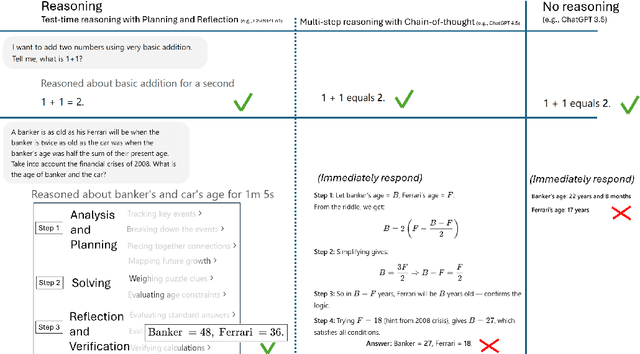

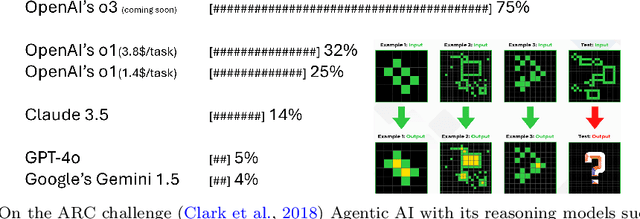

Abstract:Agentic Artificial Intelligence (AI) builds upon Generative AI (GenAI). It constitutes the next major step in the evolution of AI with much stronger reasoning and interaction capabilities that enable more autonomous behavior to tackle complex tasks. Since the initial release of ChatGPT (3.5), Generative AI has seen widespread adoption, giving users firsthand experience. However, the distinction between Agentic AI and GenAI remains less well understood. To address this gap, our survey is structured in two parts. In the first part, we compare GenAI and Agentic AI using existing literature, discussing their key characteristics, how Agentic AI remedies limitations of GenAI, and the major steps in GenAI's evolution toward Agentic AI. This section is intended for a broad audience, including academics in both social sciences and engineering, as well as industry professionals. It provides the necessary insights to comprehend novel applications that are possible with Agentic AI but not with GenAI. In the second part, we deep dive into novel aspects of Agentic AI, including recent developments and practical concerns such as defining agents. Finally, we discuss several challenges that could serve as a future research agenda, while cautioning against risks that can emerge when exceeding human intelligence.
Using Phonemes in cascaded S2S translation pipeline
Apr 22, 2025Abstract:This paper explores the idea of using phonemes as a textual representation within a conventional multilingual simultaneous speech-to-speech translation pipeline, as opposed to the traditional reliance on text-based language representations. To investigate this, we trained an open-source sequence-to-sequence model on the WMT17 dataset in two formats: one using standard textual representation and the other employing phonemic representation. The performance of both approaches was assessed using the BLEU metric. Our findings shows that the phonemic approach provides comparable quality but offers several advantages, including lower resource requirements or better suitability for low-resource languages.
Causally Reliable Concept Bottleneck Models
Mar 06, 2025Abstract:Concept-based models are an emerging paradigm in deep learning that constrains the inference process to operate through human-interpretable concepts, facilitating explainability and human interaction. However, these architectures, on par with popular opaque neural models, fail to account for the true causal mechanisms underlying the target phenomena represented in the data. This hampers their ability to support causal reasoning tasks, limits out-of-distribution generalization, and hinders the implementation of fairness constraints. To overcome these issues, we propose \emph{Causally reliable Concept Bottleneck Models} (C$^2$BMs), a class of concept-based architectures that enforce reasoning through a bottleneck of concepts structured according to a model of the real-world causal mechanisms. We also introduce a pipeline to automatically learn this structure from observational data and \emph{unstructured} background knowledge (e.g., scientific literature). Experimental evidence suggest that C$^2$BM are more interpretable, causally reliable, and improve responsiveness to interventions w.r.t. standard opaque and concept-based models, while maintaining their accuracy.
Improving Next Tokens via Second-Last Predictions with Generate and Refine
Nov 23, 2024



Abstract:Autoregressive language models like GPT aim at predicting next tokens, while autoencoding models such as BERT are trained on tasks such as predicting masked tokens. We train a decoder only architecture for predicting the second last token for a sequence of tokens. Our approach yields higher computational training efficiency than BERT-style models by employing a structured deterministic approach towards masking tokens. We use our model to improve the next token predictions of a standard GPT by combining both predictions in a ``generate-then-refine'' approach. We show on different variants of GPT-2 and different datasets that (not unexpectedly) second last token predictions are much more accurate, i.e., more than 15\% higher accuracy than ordinary next token predictors. The ``generate-then-refine'' approach also demonstrates notable improvements in next-token predictions, yielding smaller yet consistent and significant gains.
Empowering Clients: Transformation of Design Processes Due to Generative AI
Nov 22, 2024Abstract:The domain of computational design, driven by advancements in Generative AI, is transforming creative fields. We explore the transformative effects of Generative AI on the architectural design process and discuss the role of the architect. The case of architecture is interesting as designing houses is complex, involving extensive customer interaction. We employ a within-subject experiment using a popular general-purpose text-to-image tool for generating designs and providing feedback on existing designs, followed by expert interviews. The study reveals that AI can disrupt the ideation phase by enabling clients to engage in the design process through rapid visualization of their own ideas. In turn, the architect's role shifts more towards assessing the feasibility of designs generated conjointly by clients and AI. Our study also shows that while AI can provide valuable feedback on designs, it might fail to generate such designs, allowing for interesting connections to foundations in computer science, i.e., NP-completeness. AI's feedback also tends to hamper creativity and innovation by suggesting altering novel, innovative approaches toward more standardized designs. Our study also reveals that there is uncertainty among architects about the interpretative sovereignty of architecture and loss of meaning and identity when AI increasingly takes over authorship in the design process.
Topic Modeling with Fine-tuning LLMs and Bag of Sentences
Aug 06, 2024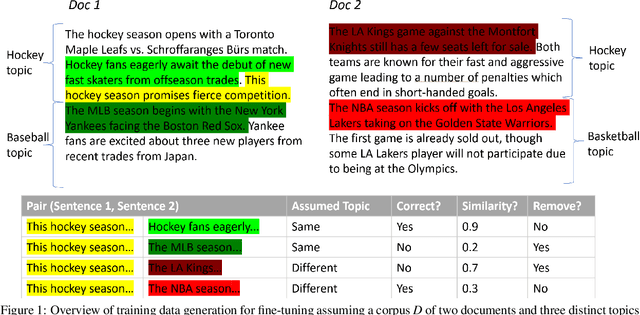

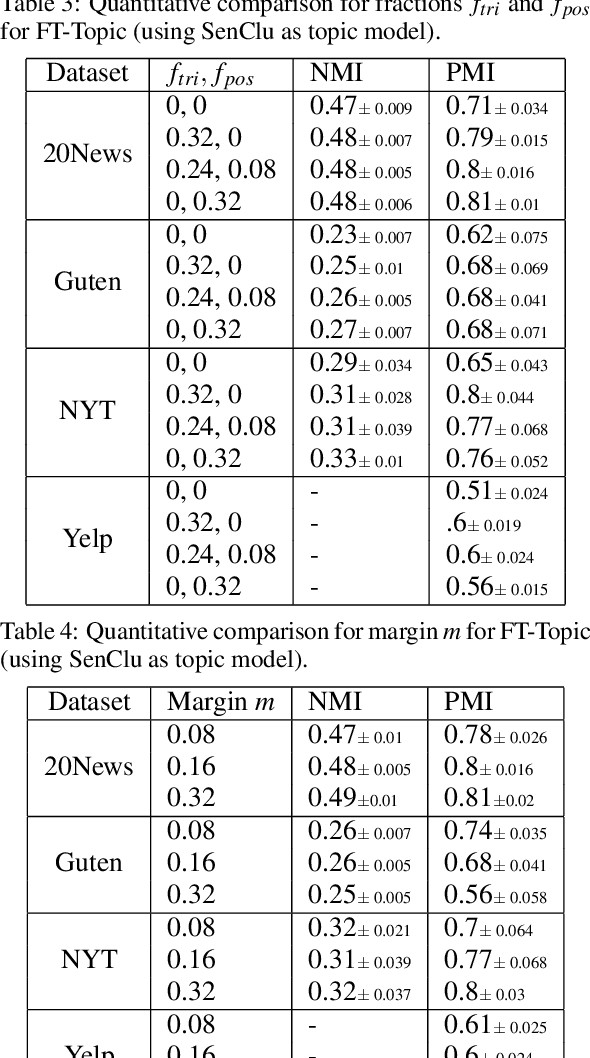
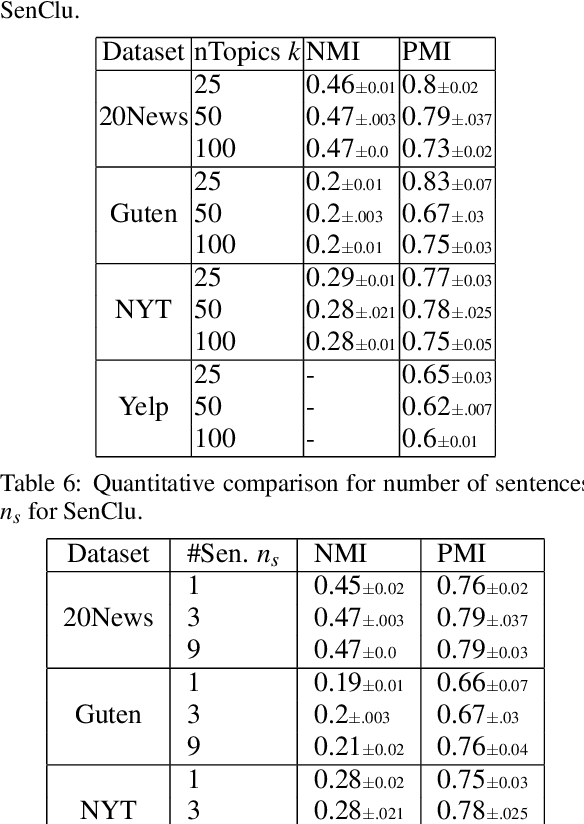
Abstract:Large language models (LLM)'s are increasingly used for topic modeling outperforming classical topic models such as LDA. Commonly, pre-trained LLM encoders such as BERT are used out-of-the-box despite the fact that fine-tuning is known to improve LLMs considerably. The challenge lies in obtaining a suitable (labeled) dataset for fine-tuning. In this paper, we use the recent idea to use bag of sentences as the elementary unit in computing topics. In turn, we derive an approach FT-Topic to perform unsupervised fine-tuning relying primarily on two steps for constructing a training dataset in an automatic fashion. First, a heuristic method to identifies pairs of sentence groups that are either assumed to be of the same or different topics. Second, we remove sentence pairs that are likely labeled incorrectly. The dataset is then used to fine-tune an encoder LLM, which can be leveraged by any topic modeling approach using embeddings. However, in this work, we demonstrate its effectiveness by deriving a novel state-of-the-art topic modeling method called SenClu, which achieves fast inference through an expectation-maximization algorithm and hard assignments of sentence groups to a single topic, while giving users the possibility to encode prior knowledge on the topic-document distribution. Code is at \url{https://github.com/JohnTailor/FT-Topic}
What comes after transformers? -- A selective survey connecting ideas in deep learning
Aug 01, 2024

Abstract:Transformers have become the de-facto standard model in artificial intelligence since 2017 despite numerous shortcomings ranging from energy inefficiency to hallucinations. Research has made a lot of progress in improving elements of transformers, and, more generally, deep learning manifesting in many proposals for architectures, layers, optimization objectives, and optimization techniques. For researchers it is difficult to keep track of such developments on a broader level. We provide a comprehensive overview of the many important, recent works in these areas to those who already have a basic understanding of deep learning. Our focus differs from other works, as we target specifically novel, alternative potentially disruptive approaches to transformers as well as successful ideas of recent deep learning. We hope that such a holistic and unified treatment of influential, recent works and novel ideas helps researchers to form new connections between diverse areas of deep learning. We identify and discuss multiple patterns that summarize the key strategies for successful innovations over the last decade as well as works that can be seen as rising stars. Especially, we discuss attempts on how to improve on transformers covering (partially) proven methods such as state space models but also including far-out ideas in deep learning that seem promising despite not achieving state-of-the-art results. We also cover a discussion on recent state-of-the-art models such as OpenAI's GPT series and Meta's LLama models and, Google's Gemini model family.
Exploring Human-LLM Conversations: Mental Models and the Originator of Toxicity
Jul 08, 2024



Abstract:This study explores real-world human interactions with large language models (LLMs) in diverse, unconstrained settings in contrast to most prior research focusing on ethically trimmed models like ChatGPT for specific tasks. We aim to understand the originator of toxicity. Our findings show that although LLMs are rightfully accused of providing toxic content, it is mostly demanded or at least provoked by humans who actively seek such content. Our manual analysis of hundreds of conversations judged as toxic by APIs commercial vendors, also raises questions with respect to current practices of what user requests are refused to answer. Furthermore, we conjecture based on multiple empirical indicators that humans exhibit a change of their mental model, switching from the mindset of interacting with a machine more towards interacting with a human.
 Add to Chrome
Add to Chrome Add to Firefox
Add to Firefox Add to Edge
Add to Edge